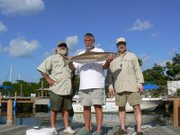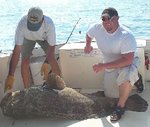Know Yo Bait
(305) 304-8656
The new Cell Number
The European pilchard, Sardina pilchardus
While the winds are marginal, my crew in town are waiting till after Christmas for their Fishing adventure. The weather isn't bad, but taking a day or two to spend with the family is generally good for martial relations. So while I am doing not on the water stuff I thought I should post some pictures of bait. The Pilchard aka Scaled Sardine, Spanish Sardine etc. etc. is a prime bait for just about anything. The larger ones, over four inches are great offshore and the small ones are like snapper candy. Having a live well full of these guys is serious fishing ammunition. They can piss off the Pope though. One day they are a no brainer to catch and the next you can waste most of your fuel for nothing. So if you are down for a while, it is a good thing to have a bait keep in the water close so you can load up in the good times. Some of the canals are not all that great for keeping bait especially if there is a lot of dead sea grass floating. So you might have to locate your keep away from the dock in some sheltered spot hoping that no one wanders off with your keep. For that reason, you will rarely see a ton of money thrown in making the bait keep to end all bait keeps. In a pinch, a garbage can with lots of holes drilled in it works fine as long as you don't over load it with bait. Strapping a fun noodle to the top keeps it floating and a bungie will keep the lid in place.
The ballyhoo or bally, Hemiramphus brasiliensis
The ballyhoo is another great bait in the Keys alive or dead. That is a good thing since they tend to prefer the dead state. You can keep ballyhoo alive in a good live well for about 6 hours if you really watch them. Just like pilchards they can be a piece of cake to catch one day and non existent the next. Most of the time they are pretty easy to catch so that is a plus. While waiting for them to show up in your chum slick, you can add a few menu items like snapper, porgies, hog fish etc. to the box if you pick a good spot.
These are the two main sailfish baits for the winter season down here. You can catch both with small hooks, size 10, a small piece of bait just about as big as the gap in the hook and a small float like for fresh water panfish will help especially for the ballyhoo. Pilchards will also take a Sabiki rig but a cast net is the way to go for both species.
If you can throw an eight foot radius cast net you can throw a 12 footer. Guides will normally use a 12 foot net. For the occasional angler a 7 of 8 foot net works just fine. Size does matter but technique is important as well. A seven foot net with an extra long lease can be just the ticket for spooky ballyhoo. With just a little practice anyone can wing a net for bait.
pinfish, Lagodon rhomboides
Pinfish are the easiest bait to catch with hook and line or with a trap. They are more of a challenge with a cast net than you might think, so I normally stick to hook and line. Pinfish are not the go to bait for sailfish but I have caught a few that didn't read the rules very well. It is better to have something than nothing, so having a few dozen in the live well is a good thing.
In addition to these basics you can have goggle eyes, threadfin herring, blue runners, small snapper, just about anything that wiggles. I have caught sailfish on all of them.
The reason for this post is a lot of my trips are devoted more to bait catching instead of fishing. Catching bait is a fishing basic and I am a basic kind of guy. It makes it easier if you know what you are looking for.
In addition to these basics you can have goggle eyes, threadfin herring, blue runners, small snapper, just about anything that wiggles. I have caught sailfish on all of them.
The reason for this post is a lot of my trips are devoted more to bait catching instead of fishing. Catching bait is a fishing basic and I am a basic kind of guy. It makes it easier if you know what you are looking for.
Marathon in the Florida Keys should be your next fishing vacation destination. Join us for charter fishing, fishing guide trips or our fishing 101 so you can fish on your own with better success.
Tight lines,
Capt. Dallas









No comments:
Post a Comment